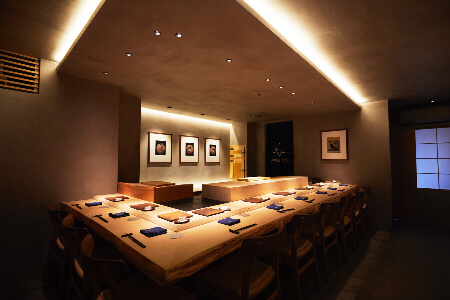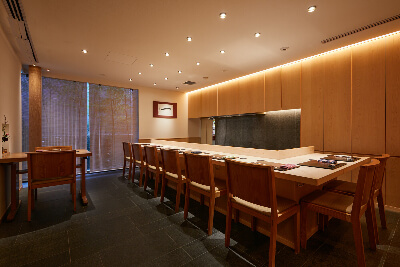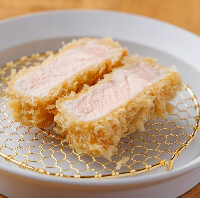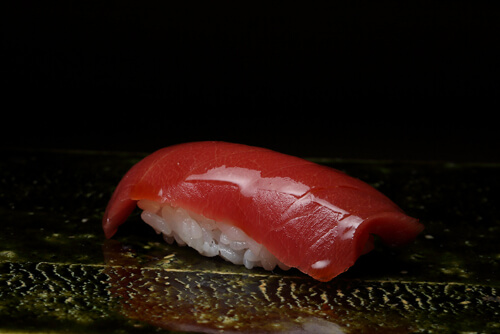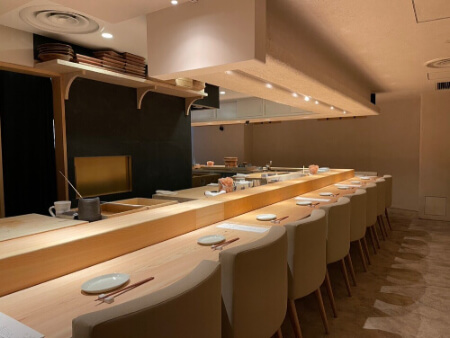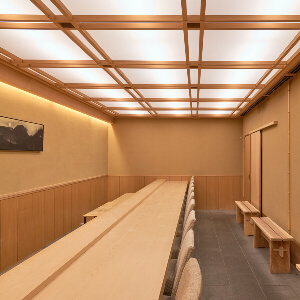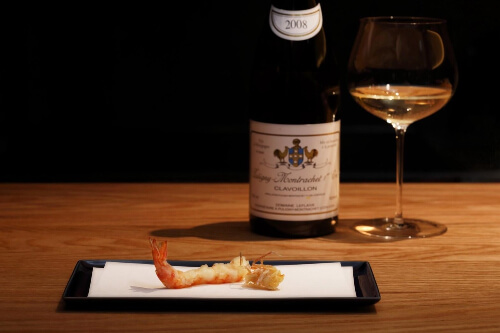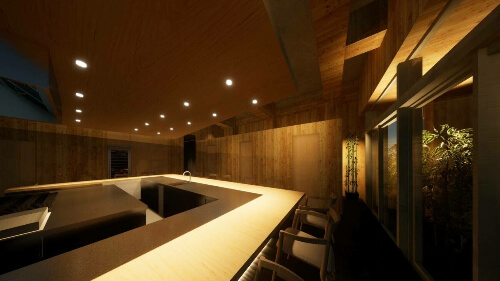Tempura

Tempura (ōVéšéń) are pieces of lightly battered, deep fried seafood and vegetables. Introduced to Japan during the 16th century by the Portuguese in Nagasaki, tempura has developed over the centuries into a popular Japanese dish both inside and outside of Japan. Tempura can be found in many types of restaurants across the country, where it is commonly served as a main dish, side dish or as a topping for tendon rice bowls, or udon and soba noodle dishes. The following are some of the most popular varieties of tempura pieces:
Where to find tempura
The best place to try tempura are restaurants specialized in the dish, known as tempura-ya. Tempura-ya have the reputation of being high-class restaurants, where customers often sit at the counter and watch as the chef prepares one tempura piece after the other. A meal at upmarket establishments typically costs 5000 yen or more. However, cheaper tempura-ya are also popular, with set meals and tendon rice bowls typically available for 800 to 3000 yen.
Casual restaurants such as izakaya, family restaurants, shokudo, and udon and soba restaurants also serve tempura as part of a set meal or as a side dish. Prices vary but typically range from 600 to 2000 yen. Tendon (tempura rice bowls) are also common with prices starting from around 800 yen. Supermarkets and department store basement food floors (depachika) also sell individual pieces of tempura for about 100 to 400 yen per piece.

How to eat tempura
At upmarket tempura-ya, the chef will typically serve the tempura starting with lighter flavored items like shrimp and fish, before moving towards stronger flavored items like root vegetables. Fish and shrimp tempura can be eaten in their entirety, however many people leave the heads and tails if present.
Tempura pieces are usually individually seasoned with salt or dipped into a dipping sauce before eaten. Usually only one of the two types of seasonings is available, depending on the establishment. Salt is sometimes matcha or wasabi flavored, while dipping sauces are often accompanied by a small bowl of grated daikon (giant white radish) to be added into the sauce.
Tendon rice bowls are served with a sweet and savory sauce already drizzled over the tempura and usually come with pickles and miso soup. There is no need to further season the tempura pieces. Tempura served as toppings in noodle soups, too, do not usually come with any additional seasonings.

Questions? Ask in our forum.
Restaurants
-
-
![]() Udatsu Sushi (Tokyo)Awarded One Star in 2024 - People from around the world visit to experience Mr. Udatsu's sushi. Inside the restaurant, which resembles an art gallery with its modern decor and numerous artworks, guests can enjoy sushi crafted from the highest quality ingredients. While the foundation is traditional nigiri, the menu also features original creations born from the chef's relentless curiosity and innovation.View on JapanEatinerary
Udatsu Sushi (Tokyo)Awarded One Star in 2024 - People from around the world visit to experience Mr. Udatsu's sushi. Inside the restaurant, which resembles an art gallery with its modern decor and numerous artworks, guests can enjoy sushi crafted from the highest quality ingredients. While the foundation is traditional nigiri, the menu also features original creations born from the chef's relentless curiosity and innovation.View on JapanEatinerary -
![]() Waketokuyama (Tokyo)Awarded One Star in 2025 - With a meticulous focus on allowing guests to enjoy seasonal ingredients at their peak, the menu changes approximately every two weeks. The signature dish, "Grilled Abalone with Seaweed Aroma," features thick slices of abalone generously coated in a rich liver sauce, offering an exquisite taste of the sea.View on JapanEatinerary
Waketokuyama (Tokyo)Awarded One Star in 2025 - With a meticulous focus on allowing guests to enjoy seasonal ingredients at their peak, the menu changes approximately every two weeks. The signature dish, "Grilled Abalone with Seaweed Aroma," features thick slices of abalone generously coated in a rich liver sauce, offering an exquisite taste of the sea.View on JapanEatinerary -
![]() Sushiroku (Osaka)Awarded One Star in 2024 - A cozy, family-run restaurant managed by a husband and wife. They are deeply committed to perfecting their shari (sushi rice) and use two types of vinegared rice tailored to complement each topping. Since 2019, the restaurant has consistently earned stars.View on JapanEatinerary
Sushiroku (Osaka)Awarded One Star in 2024 - A cozy, family-run restaurant managed by a husband and wife. They are deeply committed to perfecting their shari (sushi rice) and use two types of vinegared rice tailored to complement each topping. Since 2019, the restaurant has consistently earned stars.View on JapanEatinerary -
![]() Fry-ya (Tokyo)Exquisite fried dishes crafted by a head chef with experience earning stars in both Switzerland and Japan. The remarkably light tonkatsu is a favorite not only among Japanese diners but also among visitors to Japan. With the theme of "small portions, many varieties," guests can enjoy sampling a wide selection of tonkatsu in smaller portions.View on JapanEatinerary
Fry-ya (Tokyo)Exquisite fried dishes crafted by a head chef with experience earning stars in both Switzerland and Japan. The remarkably light tonkatsu is a favorite not only among Japanese diners but also among visitors to Japan. With the theme of "small portions, many varieties," guests can enjoy sampling a wide selection of tonkatsu in smaller portions.View on JapanEatinerary -
![]() Sushi Hayashi (Kyoto)Awarded One Star in 2024 - A unique sushi restaurant that blends traditional Edomae (Tokyo-style) sushi with Kyoto-style sushi, such as mackerel sushi and steamed sushi, in its courses. The head chef, who trained as a sushi artisan in Switzerland, carefully selects Swiss wines, making them a perfect pairing to enjoy with the meal.View on JapanEatinerary
Sushi Hayashi (Kyoto)Awarded One Star in 2024 - A unique sushi restaurant that blends traditional Edomae (Tokyo-style) sushi with Kyoto-style sushi, such as mackerel sushi and steamed sushi, in its courses. The head chef, who trained as a sushi artisan in Switzerland, carefully selects Swiss wines, making them a perfect pairing to enjoy with the meal.View on JapanEatinerary -
![]() Hikarimono (Tokyo)With a prime location and quality that rivals high-end sushi restaurants, this restaurant maintains the goal of being a place for everyday dining. It offers a casual and relaxed atmosphere, free from stiffness or formality. The signature "Hikari-maki," featuring ingredients such as sardines, pickled plum, and bettarazuke (sweet pickled radish), boasts unique flavors that are especially popular among international visitors.View on JapanEatinerary
Hikarimono (Tokyo)With a prime location and quality that rivals high-end sushi restaurants, this restaurant maintains the goal of being a place for everyday dining. It offers a casual and relaxed atmosphere, free from stiffness or formality. The signature "Hikari-maki," featuring ingredients such as sardines, pickled plum, and bettarazuke (sweet pickled radish), boasts unique flavors that are especially popular among international visitors.View on JapanEatinerary -
![]() Noguchi Tsunagu (Kyoto)Awarded One Star in 2024 - The sister restaurant of the highly exclusive Japanese cuisine establishment, Kyotenjin Noguchi. While maintaining the culinary essence of the main branch, this kappo-style restaurant incorporates ingredients from the chefŌĆÖs hometown in the Goto Islands. Its signature dish, Nikusui, is a masterpiece made from carefully prepared, top-quality A5-grade sirloin.View on JapanEatinerary
Noguchi Tsunagu (Kyoto)Awarded One Star in 2024 - The sister restaurant of the highly exclusive Japanese cuisine establishment, Kyotenjin Noguchi. While maintaining the culinary essence of the main branch, this kappo-style restaurant incorporates ingredients from the chefŌĆÖs hometown in the Goto Islands. Its signature dish, Nikusui, is a masterpiece made from carefully prepared, top-quality A5-grade sirloin.View on JapanEatinerary -
![]() TEMPURA & WINE SHINO (Tokyo)The kind of restaurant that is known only to true gourmets, serving as a sort of 'Hidden gem'. In a chic space with black walls and a ceiling adorned in gold, you can enjoy tempura with a light and elegant texture, delicately fried using refined techniques to achieve a thin, white batter that minimizes the aroma of oil. Savor tempura that maximizes the flavors of the ingredients, paired with Champagne and Burgundy wines carefully selected by the sommelier.View on JapanEatinerary
TEMPURA & WINE SHINO (Tokyo)The kind of restaurant that is known only to true gourmets, serving as a sort of 'Hidden gem'. In a chic space with black walls and a ceiling adorned in gold, you can enjoy tempura with a light and elegant texture, delicately fried using refined techniques to achieve a thin, white batter that minimizes the aroma of oil. Savor tempura that maximizes the flavors of the ingredients, paired with Champagne and Burgundy wines carefully selected by the sommelier.View on JapanEatinerary -
![]() Ginza Nominokoji Yamagishi (Tokyo)Tominokoji Yamagishi, an exclusive kaiseki restaurant from Kyoto, has opened its first location in Tokyo. Unlike its main branch, this establishment adopts an izakaya-style format, allowing diners to enjoy a more relaxed ├Ā la carte dining experience. Despite being located in Tokyo, the restaurant meticulously sources ingredients and even water from Kyoto, dedicating itself to faithfully recreating KyotoŌĆÖs culinary traditions.View on JapanEatinerary
Ginza Nominokoji Yamagishi (Tokyo)Tominokoji Yamagishi, an exclusive kaiseki restaurant from Kyoto, has opened its first location in Tokyo. Unlike its main branch, this establishment adopts an izakaya-style format, allowing diners to enjoy a more relaxed ├Ā la carte dining experience. Despite being located in Tokyo, the restaurant meticulously sources ingredients and even water from Kyoto, dedicating itself to faithfully recreating KyotoŌĆÖs culinary traditions.View on JapanEatinerary -
![]() Kitashinchi Kushikatsu Bon (Osaka)A restaurant that elevates Osaka's soul food, kushikatsu, to a luxurious level. Skilled chefs meticulously prepare each skewer using carefully selected premium ingredients such as Chateaubriand and foie gras. The skewers are fried in a custom copper pot using a unique oil blend based on cottonseed oil, enhancing the natural flavors of the ingredients.View on JapanEatinerary
Kitashinchi Kushikatsu Bon (Osaka)A restaurant that elevates Osaka's soul food, kushikatsu, to a luxurious level. Skilled chefs meticulously prepare each skewer using carefully selected premium ingredients such as Chateaubriand and foie gras. The skewers are fried in a custom copper pot using a unique oil blend based on cottonseed oil, enhancing the natural flavors of the ingredients.View on JapanEatinerary
-









